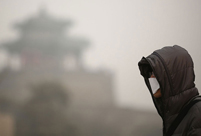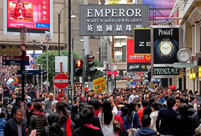 'Jin' named the word of the year by cross-strait netizens
'Jin' named the word of the year by cross-strait netizens Chinese scientific expedition goes to build new Antarctica station
Chinese scientific expedition goes to build new Antarctica station
 Chinese naval escort fleet conducts replenishment in Indian Ocean
Chinese naval escort fleet conducts replenishment in Indian Ocean 17th joint patrol of Mekong River to start
17th joint patrol of Mekong River to start China's moon rover, lander photograph each other
China's moon rover, lander photograph each other Teaming up against polluters
Teaming up against polluters
BEIJING, Jan. 2 -- The average PM 2.5 reading for Beijing in 2013 was more than double the national standard, the city's environmental authority reported Thursday, suggesting tough challenges ahead for the pollution-plagued Chinese capital in its anti-smog campaign.
Beijing's average PM 2.5 index, which measures airborne particles smaller than 2.5 micrometers, stood at 89.5 micrograms per cubic meter in 2013, the Beijing Municipal Environmental Protection Bureau said in a press release.
The reading was 2.56 times the national standard of 35, which was set by the State Council in 2012 in a set of revised air quality standards that included indices for ozone and PM 2.5.
Beijing began PM 2.5 monitoring in 2013 amid mounting public complaints about frequent bouts of smog.
The city reported 58 days of heavy pollution last year, compared with 176 days of excellent or fairly good air, said Zhang Dawei, director of the Beijing Municipal Environmental Monitoring Center.
"It suggests that, on average, heavy air pollution occurred every six or seven days," Zhang said.
Finer particles as measured by PM 2.5 had become the city's primary polluter, accounting for 77.8 percent of air pollution, followed by ozone, which made up 20.1 percent, according to Zhang.
The tiny PM 2.5 can go deep into the lungs, thus posing a greater health threat than PM 10.
The Beijing Municipal Environmental Protection Bureau said it aims to bring down the city's average PM 2.5 index to 60 in 2017 by reducing coal burning, limiting car ownership and other industrial polluters.
The city slashed its coal use by 1.3 million tonnes, phased out 35,000 motor vehicles, and overhauled or closed 288 factories in 2013 in its campaign to cut air pollution, according to city officials.
 Commemorate 120th birth anniversary of Mao Zedong
Commemorate 120th birth anniversary of Mao Zedong Female soldiers of PLA Marine Corps in training
Female soldiers of PLA Marine Corps in training Chinese cities to have a very grey Christmas as smog persists
Chinese cities to have a very grey Christmas as smog persists China and U.S. - the national image in each other’s eyes
China and U.S. - the national image in each other’s eyes The Liaoning's combat capability tested in sea trial
The Liaoning's combat capability tested in sea trial Chinese pole dancing team show their moves in snow
Chinese pole dancing team show their moves in snow Rime scenery in Mount Huangshan
Rime scenery in Mount Huangshan Ronnie O'Sullivan: My children mean the world to me
Ronnie O'Sullivan: My children mean the world to me Shopping in Hong Kong: a different picture
Shopping in Hong Kong: a different picture Yearender: Animals' life in 2013
Yearender: Animals' life in 2013 Hello 2014 - Chinese greet the New Year
Hello 2014 - Chinese greet the New Year Chocolate 'Terracotta Warriors' appear
Chocolate 'Terracotta Warriors' appear  Top 10 domestic news of 2013
Top 10 domestic news of 2013 Red crabs begin annual migrations in Australia
Red crabs begin annual migrations in Australia Artifacts retrieved from West Zhou Dynasty
Artifacts retrieved from West Zhou DynastyDay|Week|Month